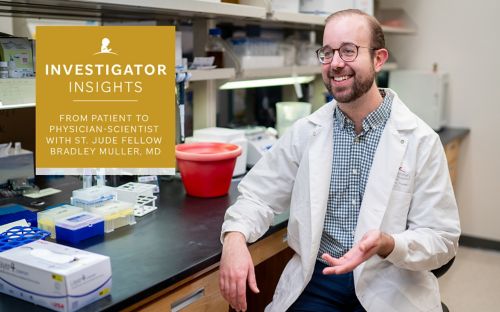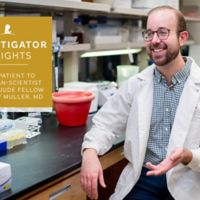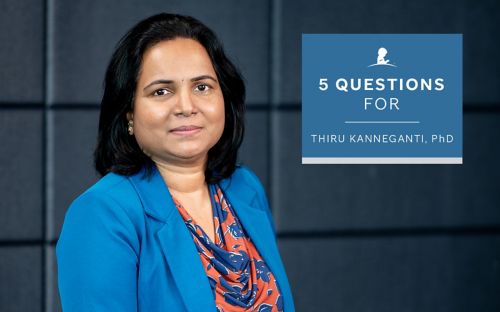Investigator Insights: Bringing science into the clinic with Kelsey Bertrand, MD
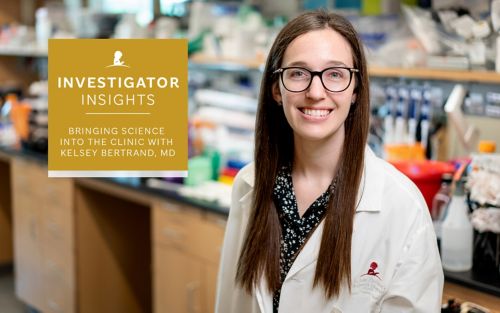
Kelsey Bertrand, MD, is working to translate research findings into new clinical trials for ependymoma.
Science is a team sport. It sounds cheesy, but it’s still true. In science, as in athletics, it matters both who is on your team and how you function together. In my work as a pediatric neuro-oncologist at St. Jude, our clinical team comprises physicians, advanced practice professionals, nurses, pharmacists, coordinators and host of other specialties. Together, we are working to provide the best possible care for children with brain tumors. To improve outcomes and offer patients new therapies, we also need scientists on our team.
I wanted to be a laboratory research scientist right up to the moment when I decided to go to medical school. At the time, I was working toward a Master’s degree in the laboratory of Michael Taylor, MD, PhD, at the Hospital for Sick Children (SickKids) in Toronto; his lab is now at Texas Children’s/Baylor College of Medicine. My years in the lab were formative; it was an exciting time to study brain tumors, with discoveries changing how the scientific community approached these diseases.
For example, one of my colleagues in the Taylor lab, Paul Northcott, PhD, who at the time was a PhD student, discovered that there are four molecular groups of the brain tumor medulloblastoma. Today, Paul is still a colleague since our paths brought us both to St. Jude, where he directs the Center of Excellence in Neuro-Oncology Sciences and is a Department of Developmental Neurobiology member.
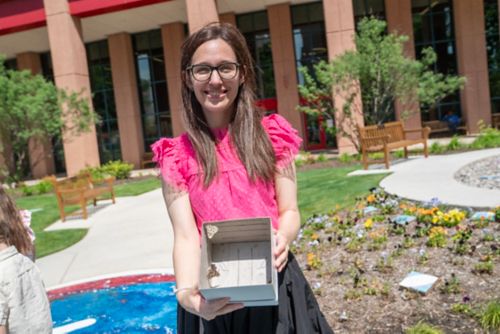
Kelsey Bertrand, MD, holds butterflies during a release event for ependymoma awareness.
Another colleague from the Taylor lab I still work with is Stephen Mack, PhD, St. Jude Department of Developmental Neurobiology. While earning his PhD, Stephen found two different molecular types of posterior fossa ependymoma, one of the tumors we both now focus on. I didn’t realize it then, but while I was in the lab, I was meeting people who would become valued team members later. Not to mention that, personally, I met my future husband — Stephen and I married in 2012.
While witnessing these discoveries was compelling, I felt pulled in a different direction. I wanted to work with patients and conduct research that would bridge the gap between discoveries in the laboratory and the treatment options available in the clinic.
Changing focus toward clinical research for pediatric brain tumors
Medical school took me to Australia, where I attended the University of Queensland. When I entered medical school, I already knew my specialty would be pediatric neuro-oncology. Childhood brain tumors lag in terms of both scientific discovery and the development of new treatments. There are numerous reasons for this, including their biological complexity, the inherent challenges of treating a disease in the brain and the necessity of therapeutics that cross the blood-brain barrier (a physical separation between the brain and the rest of the body). I wanted to work in a field where I believed there was an opportunity to make a transformative difference.
I loved medical school — certainly, living in Australia and having opportunities to travel was wonderful — but it was also a time when I had opportunities to learn so many exciting things. After medical school, I completed my residency in pediatrics at Cleveland Clinic Children’s Hospital, where I was mentored by Tanya Tekautz, MD, who is no longer with us but was a wonderfully supportive mentor. From there, I moved on to a fellowship in pediatric hematology-oncology at Baylor College of Medicine.
Throughout my training, I maintained an interest in research, even spending time in the lab. I was also still connected to St. Jude — I knew people who had trained here and had even rotated at the hospital myself, meeting Amar Gajjar, MD, Department of Pediatric Medicine chair; Giles Robinson, MD, who today is the Division of Neuro-Oncology director; and Ibrahim Qaddoumi, MD, who today is the St. Jude Global Neuro-Oncology Program director. At the time, I was struck by the St. Jude approach to learning and training, where even the most senior people dedicated time to ensuring I understood, explaining things patiently and providing tremendous support.
When it was time to make a professional change, I decided to join the team at St. Jude. St. Jude has an unparalleled ability to conduct clinical research, with close connections to the scientific discoveries occurring in the labs built into the team approach to our work — something I knew would be vital to my career. I wanted to focus on clinical research, developing clinical trials based on the latest advances from the laboratory.
A team approach to finding options for ependymoma
There are many different types of brain tumors, but I have focused on ependymoma. Ependymoma is the third most common malignant pediatric brain tumor, with about 200 new cases in the U.S. each year. These tumors can occur anywhere in the central nervous system (the brain or spine), but two-thirds of cases occur in the posterior fossa, in the cerebellum at the back of the brain. The overall survival at five years after diagnosis is around 75%; however, at 10 years after diagnosis, survival is closer to 50% — this decrease is because ependymoma often relapses after a longer period than other tumors.
The standard of care for ependymoma is removal by surgery, if possible, followed by radiation. The most recent Children’s Oncology Group clinical trial for ependymoma was ACNS0831, which examined whether survival was better if radiation was given before chemotherapy or if radiation was given alone. The results showed that chemotherapy does not improve survival. There is a real need for novel therapies for these patients — simply offering them radiation, which has been available for decades, is not enough.
In the last decade, we have learned so much about the biology of ependymoma. There are 10 molecular subgroups. Many supratentorial ependymomas, an uncommon type located within the cerebral hemispheres, are driven by the ZFTA–RELA gene fusion. A 1q gain and/or 6q loss in posterior fossa–A ependymoma lead to a worse prognosis. The list goes on. But despite these discoveries, we still haven’t found novel therapeutics that will push survival curves further. Our team at St. Jude is trying to change that.
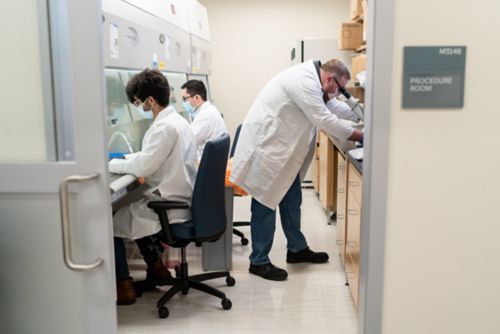
Scientists at work in the Mack lab at St. Jude.
With the Mack lab, we are working on preclinical trials and testing different targeted treatment approaches in mouse models of ependymoma. Targeted therapies lock on to a protein or other factors in the cell that the tumor needs to survive. They are more specific than whole-body treatments such as radiation and chemotherapy, and thus, we hope they will have reduced systemic side effects. Based on our findings in the lab, I’m now developing a clinical trial protocol to take what we’ve learned in the lab and create the first up-front ependymoma clinical trial in the history of St. Jude.
I don’t think it would have been possible anywhere else to go from the lab to the cusp of the clinic in the two and a half years that I have been at St. Jude. The ability to test potential treatment approaches in the lab at the scale possible at St. Jude makes a tremendous difference in how quickly we can zero in on what might be working and what is worth further development.
Always on my mind as we do this work are our patients. They are an important part of our team; they’re not only the reason we do clinical research but also active contributors who help build our knowledge base. Our patients keep us looking for the next therapy — the one that will improve the future for patients who haven’t yet been diagnosed. It is a privilege to be on this St. Jude team and do this work together.



